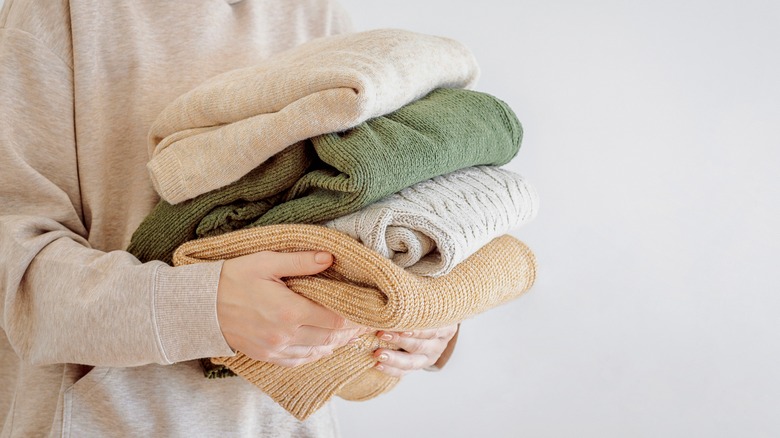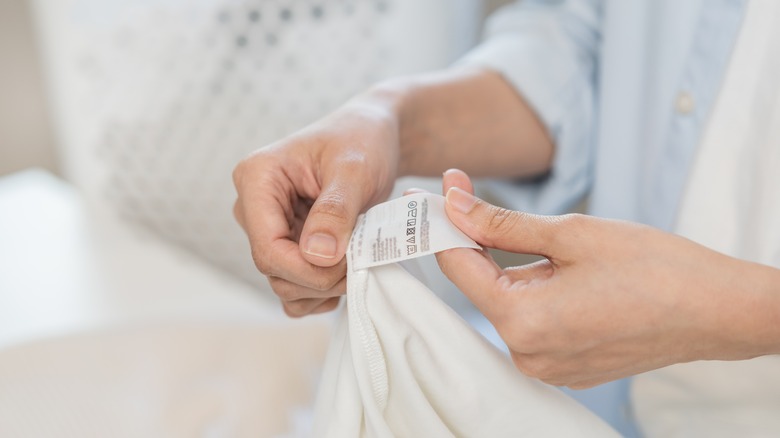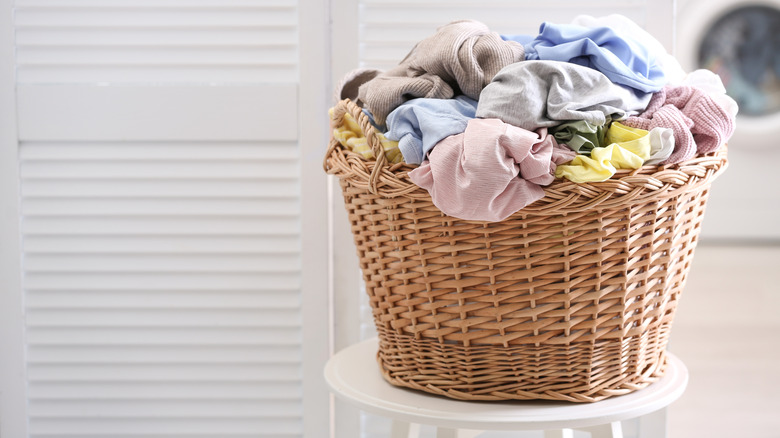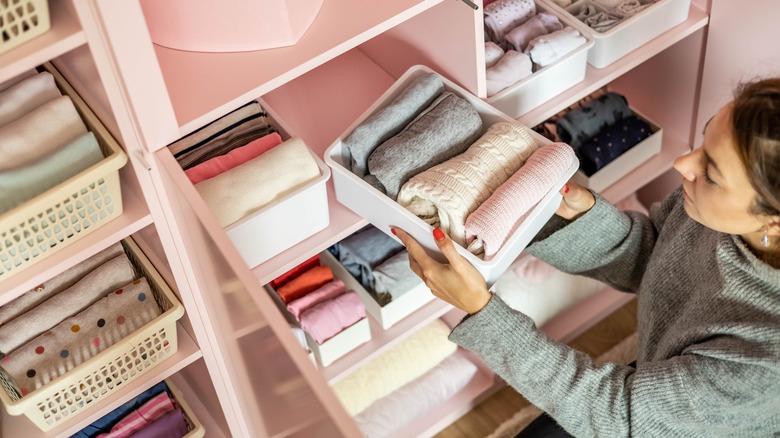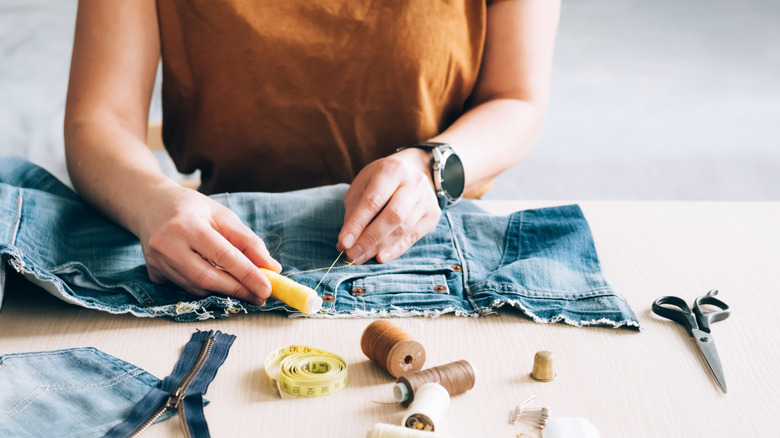How To Add Longevity To Your Cheaper, Fast Fashion Clothing
While shopping online, it's hard to ignore brands that offer the deals of a lifetime. From 50% to 75% off, fast fashion brands have unlocked the key to success. By lowering the cost of production and price, these brands are now massively wealthy. According to Business of Apps, fast fashion brand Shein, was worth $47 billion in 2021, becoming the highest-selling fashion brand.
Even though these brands sell clothing at affordable price points, their mark on the environment has drawn strong opposition. According to The New York Times, fast fashion is one of the top contributors to pollution and land waste. In 2019, the United States contributed 11.9 million tons of textile waste to landfills. This waste equals around 75 pounds of clothing per person. Much of this waste is because fast fashion clothes are being purposely made to fall apart after a few uses. On average, fast fashion clothing is made for only 10 wears before being replaced by a new product.
This endless cycle of purchasing and discarding is not only destructive to the environment but also ends up more costly for consumers. Thankfully, there are ways you can expand the lifespan of your fast fashion clothes, meaning you don't need to spend a fortune to be sustainable.
Shop fast fashion with a purpose
When shopping for fast fashion clothes, it's good to know what you are looking for ahead of time. According to Racked, one way you can be sure your clothes last a few years is by steering clear of trendy and seasonal items. Taking inventory of your wardrobe before shopping lets you know what pieces you are missing and need rather than guessing and buying blindly. It's better to incorporate aspects of trends into basic clothing pieces rather than buying only trend pieces that will last just one season.
If you don't see yourself wearing an article of clothing multiple times and in different ways, it's best not to purchase it. Making sure you buy things you can see yourself wearing past the current season ensures you won't toss them once the trend passes. Buying only what you love also helps you save money — and the environment — because you're not mindlessly purchasing articles of clothing you don't actually want. You can also make sure an item is worth your money by trying it on before you purchase it. By trying things on, you can see if it's something you can see yourself wearing in the long term (via the BBC). Similarly, if ordering online, don't be afraid to send something back instead of throwing it away if you don't like it or it doesn't fit.
Pay attention to garment labels and fabrics
Since a big part of the problem is the production and fabric choice of fast fashion clothing, it's also better to choose fabrics that are a bit higher quality and sturdier. Fabrics such as linen, Tencel, and recycled cotton make perfect examples of garments that will last a long time. Any type of natural fabric is the best bet for an eco-friendly and more robust material (via Planet Care).
Different types of fabrics will also require different types of care. According to Sustain Your Style, the best way to take care of your clothes is to follow the washing and care instructions included. Garment labels for specialized fabrics will typically have specific care instructions for that fabric to maintain their shapes. This is especially true if you reach for a higher quality fabric for fast fashion; it may cost a bit more than you're used to, but the quality is worth it.
Wash your fast fashion clothing with care
Even if you have bought something from a fast fashion store, you should still take care of it like it was worth more. Since fast fashion clothes are made with less craftsmanship, they need to be handled with more care to have them last longer. Wash your clothing on a delicate cycle or handwash it to prevent loose threads or frays. You will also want to separate your clothes as much as possible before washing them. Try not to wash bulkier items with lighter fabrics to prevent them from damaging each other (via Byrdie).
Before throwing your clothes in the wash, you should also consider whether it's worth another wear. Since fast fashion clothes have less fabric quality, overwashing them makes them prone to more tumbling, stretching, and pulls. Giving them at least three wears before washing them makes sure you aren't weakening your fabric. When you've decided to throw your clothes in the wash, be sure to lower the temperature because cold water can help maintain the clothing's integrity. The best alternative to washing would be a handwash where you can be a bit more delicate with your clothes and help them last longer (via The Good Tee).
How to store your clothes correctly
According to Pebble Magazine, one of the best ways we can continue to care for our clothes is by storing them carefully. Most metal hangers do not help to keep the structure of clothes and actually make them sag over time. Instead, use a wooden hanger, as it can hold the form better. For thicker clothing like sweaters, fold them instead of hanging them to prevent stretching from happening. Another threat to your clothes is moths. These bugs like to chew holes into clothing, which no one wants. To prevent this, occasionally spread lavender oils, thyme, or rosemary to keep them away.
As Cosmopolitan suggests, another way to keep your clothing safe from wear and tear is using garment and dust bags. If you pick up handbags or shoes at your favorite fast fashion store, keep any dust bags they might be wrapped in. These dust bags will help you preserve the quality of your items without much work. Garment bags are also useful for those special event items you picked up and may want to wear again.
Mend and fix your clothes regularly
If you've tried everything to keep your clothing intact but find small rips or holes, you can also try to fix them yourself. Instead of throwing away a good item, you can reuse them by making it into another clothing item. An example would be a pair of jeans that you no longer like; grab a pair of scissors to turn those jeans into your new favorite pair of shorts. These items can also become household items you may need like old rags or quilts (via Better World Apparel).
According to Bags of Ethics, a must-have tool for anyone wanting to keep their clothing for longer is a clothing shaver. Instead of throwing away any clothing item showing signs of pilling or loose threads, you can use a clothing shaver or an old razor to make it new again. Shaving away bobbles lets you get at least another couple of uses out of your item before needing a new one.

